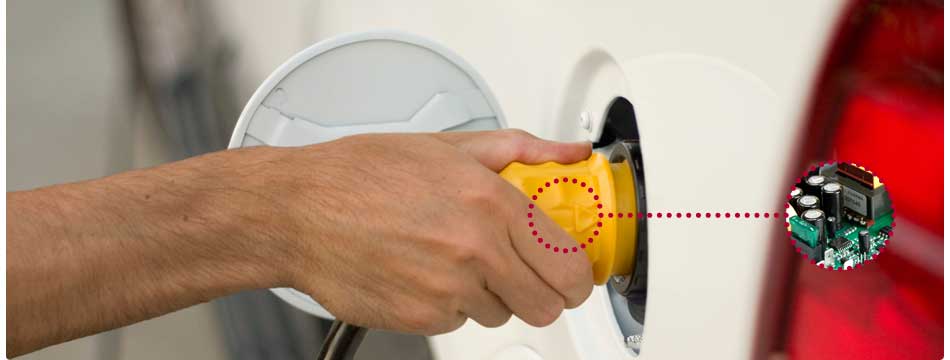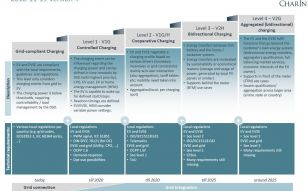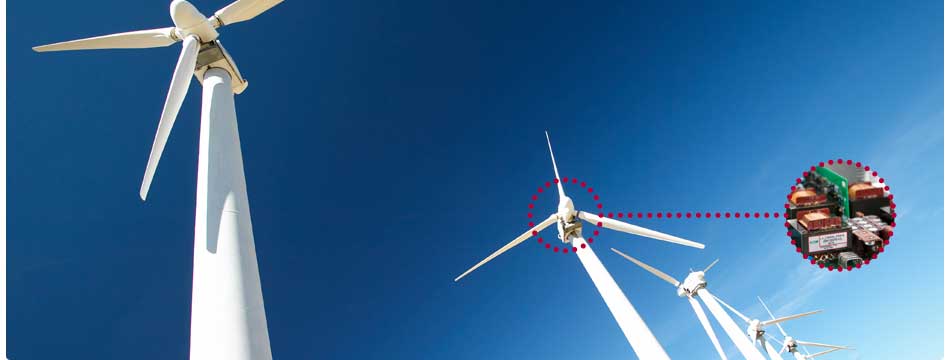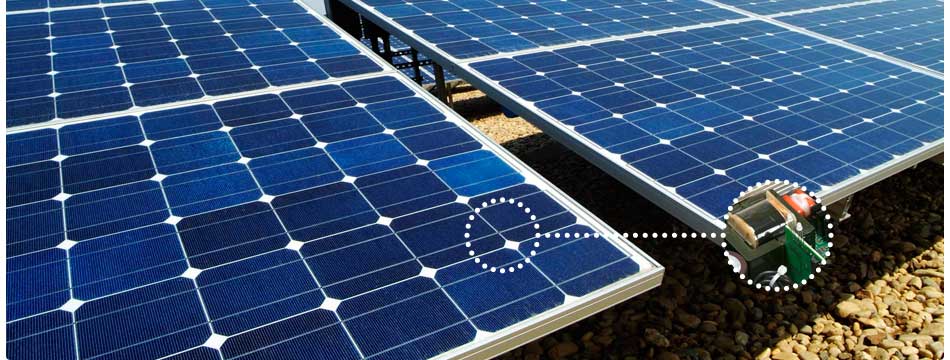
Roadmap Electric Vehicles and Grid Integration (V1G versus V2G)
Authors:
Gautham Ram, Delft University of Technology and Menno Kardolus, Power Research Electronics b.v. (PRE Power Developers)
In the next couple of years, the number of electric vehicles will increase rapidly, reaching between 23-43 million in annual sales by 2030 [1]. This will have a significant impact on the electricity grid capacity reaching between 640-1110 TWh by 2030 [1]. Approximately 2% of all new car global sales are fully electric at the moment. In the Netherlands this already leads to warnings from DSO’s who indicate that problems will arise and that investments in grid enhancement are needed. This is primarily due to the simultaneity and the high peak power of EV charging during the peak evening demand. What if 10% or maybe 20% of all the cars are electrical? Should we really spent billions on cables, transformers and power plants? Even if this would be economically feasible/viable, it is practically impossible to follow the exponential growth and popularity of EV’s.
So what should we do?
Many experts say that the grid must innovate and truly become a smart grid, and that this will enable the grid to follow the future growing demand of electrical energy . A key element in innovating the grid is to control/use the available storage from EV’s for a better utilization of the grid.
Smart charging (V1G) versus Vehicle-to-Grid (V2G)
At the moment, a lot of research is being done to integrate the grid and electric vehicles in an intelligently coordinated way. The underlying technology is available, and a lot of pilots are being conducted. There are two main technologies: V1G and V2G.
V1G is also often described as Smart Charging. With V1G, it’s possible to control the time and magnitude of charging power from the power source to the EV. V1G can be used for a multitude of applications like congestion management, frequency regulation or charging from renewables like PV. V1G is mainly interesting if the power demand (not necessarily the energy demand) becomes too high. When this is the case, one can control the power with which cars charge remotely, so that the grid will be unburdened.
V2G (Vehicle-to-Grid) goes further than that. It makes it possible to feed the energy in the batteries of the cars back to the grid. With V2G technology, it’s possible to control the time, magnitude and direction of (dis)charging power. An electric vehicle can feed power to the home (V2H) or building (V2B), to a load (V2L) or to the grid (V2G). V2G can be used for all applications of V1G but also for unique applications such as short-term storage for renewables like PV, higher capacity for frequency regulation, as well as for off-grid applications.
By bundling all the batteries of electric vehicles, an enormous virtual power plant will arise that will make the grid more stable/reliable and create economization for households, energy companies and countries.
Example V1G – controlling the EV chargers
By controlling charging power and charging moment of the day overloading of the grid can be prevented. The first chargers that need to reduce their power, or delay their charge process are those who are from user who can wait for over night charging. Clearly this may incorporate inconvenience for the EV user. To minimize this inconvenience eventually grid reinforcements can be delayed but may be needed in the future. Most experts agree that at night there is sufficient grid capacity available to charge the EV’s over night.
Example V2G – helping the grid
With V2G one can reverse the power flow and like a solar inverter the EV will act as a power generator. Looking at the above example it is clear that if the grid does not have enough day capacity to charge the EV that needs to charge urgently, a neighboring car can offer its energy to such user. From a market perspective this energy is very precious and should in fact be sold at a premium price to the EV user in need. This example illustrates that congestion management is the true market for V2G. However, the billions of EURO that can potentially be saved by a better utilization of the grid should somehow be transferred to the EV owner who is so kind to act as a local energy storage/source. At the moment there is no such positive feedback mechanism.
Main challenges for V1G/V2G
The basic technology for V1G and V2G is available. Still, a number of challenges have to be met to be able to unroll this technology on a larger scale. The biggest challenge for both V1G and V2G is the standardization and communication protocol between the various actors involved. The image (source: ElaadNL EV related protocol study v1.1) shows, which actors there are: from the electric vehicle to the DSO (the distribution system operator). The software and business contracts have to be written and the complete chain has to respond automatically within tenths of seconds. This challenge applies to both V1G and V2G. OCPP protocols will need to be updated in order to serve the V2G business case as well.
Another critical challenge is the fact that V2G is only possible with DC charging. Right now, cars are equipped with a uni-directional on-board charger. The same is valid for the charging infrastructure. At the moment the focus lies mainly on installing as many chargers as possible. Because AC chargers are a lot cheaper than DC chargers, AC chargers are being installed more frequently. To apply V2G more bi-directional onboard chargers and bi-directional DC charging infrastructure are necessary. To implement V2G, a more significant investment is needed than that required for V1G, but the revenue of V2G is potentially much higher too.
V1G / V2G and Cyber security
V1G and V2G chargers are all connected to the internet cloud. As such they could potentially be hacked by hackers. This could lead to a black-out of a big city if all chargers would start charging together – ordered by the hackers- at the same time. It is therefore very important that a V2G charger is well protected against cyber attacks and cyber criminals. At the moment there are no standards that can guide product developers and service providers to design cyber safe products and services.
V2G applications
On its own, smart charging (V1G) can have a massive impact on the grid by reducing peak demand and charging only when demand is lower. With V2G, a plethora of new opportunities open up, and five of these key applications are listed below:
1. V2G Peak shaving (Congestion management)
Buildings (Companies or residences) sign a contract with their energy network operator based on maximum usage (the peak). When the building exceeds the peak that is agreed upon, it pays an extra fee. If the company can decrease the peak, it will pay less per month. V2G is exceptionally well suited for peak shaving. The EV batteries charge during off-peak time and intercepts by discharging when there are peaks in demand. Monthly fees and maximum power usage decrease by using V2G technology.
Main criticism on this method is that there is only a penalty for peak loads, independent of the time of the day, the price of the energy at that moment and independent on the actual congestion on the grid. It is a brute force method that will have impact, but certainly will not bring together supply and demand of energy.
So the main challenge here is to create a real market for energy where supply and demand may find each other at relatively low power levels. As a result the energy infrastructure will be utilized more efficiently. On nation level this is a billion dollar market where every % of saving is worth a lot of money.
2. V2G Arbitrage Opportunities (trading)
V2G makes it possible for the EV battery to trade in the energy markets. When prices are low, energy will be bought and stored. When the price is high, the energy will be sold again. Today at house level the prices of energy hardly vary. At the energy market – eg the APX – the prices fluctuate a lot, and sometimes the prices even get negative. This means at some moments one gets paid to draw power from the grid!
3. V2G Frequency Control (FCR)
The energy grid is set up at 50Hz (60Hz in the USA). When demand peaks, the spinning reserve (multiple local generators) make sure extra energy can be supplied and that the grid remains stable. The spinning reserve basically acts as an extra buffer of available energy. Since these machines are actually spinning, keeping them operational costs for fuel and maintenance are significant. Since the batteries are controlled by the software on the bidirectional V2G converter and respond within a few seconds, this is a much more efficient solution compared to mechanical, spinning machines. V2G enabled EVs can participate in primary, secondary and (potentially) tertiary frequency control markets and will make sure that the cost for network operators will decrease. It is expected that consumers willing to contribute to this will be compensated financially.
4. V2G Microgrids and Network Outages
V2G enables you to create your own microgrid. Combining this with renewable energy sources it will be possible to be completely off-grid and still have energy. V2G can also be used as energy backup. If there are problems with the grid operator and there is a power outage, the battery can serve as a backup grid.
5. V2G Renewable Energy Buffer
Electric vehicles are seen as the sustainable future of transport. However, they are only truly sustainable if the electricity used to charge them comes from sustainable sources and not from fossil fuels. There is an evident increase in the usage of renewable energy sources like solar energy and wind energy. At the moment, this energy is being directly fed back to the grid. Smart technology makes it possible to charge cars directly from solar energy or store it in batteries. Only when the energy is not necessary anymore or when prices are right, the energy can be delivered back to the grid.
V2G business models
Due to its varied applications, V2G is a crucial tool that enables a more efficient utilisation of the grid and a high penetration of renewable energy like wind and solar energy. V2G is about solving problems with smart software versus old school investments in more cables and high-voltage lines. Besides privately owned EVs, another interesting business model is V2G Commercial EV Fleet Operations. When a company has a large fleet of cars, this fleet can be commercially deployed using V2G. Aforementioned business models like peak shaving and power outage backups can be offered to neighbouring offices.
According to research conducted by ABI Research V2G technology can ensure additional revenue of up to $2 billion for global utilities by 2025. The study says the technology could enable consumers to save up to $272 per year on their energy bills. On the other hand, other studies put the profits from V2G per vehicle in the range of $0-$8000 per year [2, 3]. The wide range goes to show how several parameters influence the V2G business models and how further research in this domain is required, including the estimation of battery degradation. The critical parameters that affect V2G revenues are the market prices ($) of ancillary services; the V2G power capacity (kW) of vehicle, charger, and distribution network; and the energy capacity (kWh) of the vehicle’s battery.
Roadmap Grid Integration
Yet another challenge for V2G is charging standards. For V2G the standard CHAdeMO is much further developed than CCS, owing to an early start in V2X in 2012. However, according to CleanTechnica CCS appears to become the dominant charging standard in Europe.
At the end of 2018, the administrator of the CCS standard (CharIn) released their own roadmap for Grid Integration Levels. This roadmap describes four different levels. Level 1 and 2 are V1G integration levels, expected to be applied by 2020. CharIn expects Level 3 (V2H) and Level 4 (V2G) will be introduced around 2025.
Solar powered Vehicle to Grid (V2G) fast charger module
Since 2009 Power Research Electronics b.v. (PRE Power Developers) is a well-known Charger Module supplier for OEM (charger) companies. Their customers provide DC Fast Charging solutions all over the world. In cooperation with the Delft University of Technology and Last Mile Solutions, PRE Power Developers recently developed and produced a 10kW solar powered bidirectional EV charger module. This first of its kind charger makes it possible to charge electric vehicles directly using solar (PV) power on DC, preventing the conversion losses from DC to AC (and back) [4]. It hence requires only one inverter for both PV and EV and is up to 17% more efficient than the current chargers exchanging power on AC. The 10kW solar powered module is hence a smart integration between an MPPT solar module and a V2G charging module. The charger can be used modular, making it possible to place several modules in parallel, to achieve a power of 150 kW. This innovative sustainable charger has received several awards, including “the Most Significant Innovation in Electric Vehicles” award from IDTechEx in Berlin and the “Best Tech idea of 2018” by science magazine KIJK.
References
1 ‘Global EV Outlook 2019’Int. Energy Agency, no date, pp. 1–143.
2 Tomić, J., Kempton, W.: ‘Using fleets of electric-drive vehicles for grid support’J. Power Sources, 2007.
3 Andersson, S.L., Elofsson, A.K., Galus, M.D., et al.: ‘Plug-in hybrid electric vehicles as regulating power providers: Case studies of Sweden and Germany’Energy Policy, 2010.
4 Chandra Mouli, G.R., Schijffelen, J.H., van den Heuvel, M., Kardolus, M., Bauer, P.: ‘A 10kW Solar-Powered Bidirectional EV Charger Compatible with Chademo and COMBO’IEEE Trans. Power Electron., 2018.
About the writers:
dr.ir. Gautham Ram is an Assistant Professor in the Department of Electrical Sustainable Energy at the Delft University of Technology, The Netherlands. He received his bachelor’s and master’s in Electrical Engineering from the National Institute of Technology Trichy, India in 2011 and the Delft University of Technology in 2013, respectively. He received his PhD from the Delft University in 2018 for the development of a solar powered V2G electric vehicle charger compatible with CHAdeMO, CCS/COMBO and designed smart charging algorithms. The project was in collaboration with PRE Power Developers, ABB and UT Austin. From 2017 to 2019, he was a postdoctoral research at TU Delft working on Flexgrid, Trolley 2.0 and Orchestrating Smart Charging project. He is also the coordinator and a lecturer for the Massive Open Online Course (MOOC) on Electric cars on edX.org. His current research focuses on electric vehicles, EV charging, PV systems, power electronics and demand-side management.
Mr. Menno Kardolus received his M. Sc. in Electrical Engineering and electrical machines at the Delft University of Technology in 1996. He is the CEO of PRE Power Developers with expertise in power electronics. He is patent holder of several power conversion patents. For more than 20 years Menno is active in power electronics for EV Charging and Renewable Energy Systems. Together with the Delft University of Technology, PRE Power Developers developed the first direct solar fast charger in the world. This research in published in IEEE Published (Transactions on Power Electronics): A 10 kW Solar-Powered Bidirectional EV Charger Compatible With Chademo and COMBO. This research won the IDTECHEX award, Berlin 2018.
Power Research Electronics BV
Minervum 7073
4817 ZK Breda
The Netherlands
T +31 (0) 76 58 11 077
F +31 (0) 76 58 11 237
E info@pr-electronics.nl
W www.pr-electronics.nl
Delft University of Technology / TU Delft
DC systems, Energy conversion & Storage group
Dept. of Electrical Sustainable Energy
Faculty of Electrical Engineering, Mathematics and Computer Science
Mekelweg 4
2628 CD Delft
The Netherlands
www.tudelft.nl
www.dcs.ewi.tudelft.nl







